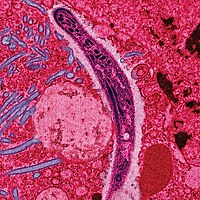
Photo from wikipedia
Background Reports suggest that asymptomatic individuals (those with no symptoms at all throughout infection) with severe acute respiratory syndrome coronavirus 2 (SARS-CoV-2) are infectious, but the extent of transmission based… Click to show full abstract
Background Reports suggest that asymptomatic individuals (those with no symptoms at all throughout infection) with severe acute respiratory syndrome coronavirus 2 (SARS-CoV-2) are infectious, but the extent of transmission based on symptom status requires further study. Purpose This living review aims to critically appraise available data about secondary attack rates from people with asymptomatic, pre-symptomatic and symptomatic SARS-CoV-2 infection. Data sources Medline, EMBASE, China Academic Journals full-text database (CNKI), and pre-print servers were searched from 30 December 2019 to 3 July 2020 using relevant MESH terms. Study selection Studies that report on contact tracing of index cases with SARS-CoV-2 infection in either English or Chinese were included. Data extraction Two authors independently extracted data and assessed study quality and risk of bias. We calculated the secondary attack rate as the number of contacts with SARS-CoV-2, divided by the number of contacts tested. Data synthesis Of 927 studies identified, 80 were included. Summary secondary attack rate estimates were 1% (95% CI: 0%-2%) with a prediction interval of 0-10% for asymptomatic index cases in 10 studies, 7% (95% CI: 3%-11%) with a prediction interval of 1- 40% for pre-symptomatic cases in 11 studies and 6% (95% CI: 5%-8%) with a prediction interval of 5- 38% for symptomatic index cases in 40 studies. The highest secondary attack rates were found in contacts who lived in the same household as the index case. Other activities associated with transmission were group activities such as sharing meals or playing board games with the index case, regardless of the disease status of the index case. Limitations We excluded some studies because the index case or number of contacts were unclear. Conclusion Asymptomatic patients can transmit SARS-CoV-2 to others, but our findings indicate that such individuals are responsible for fewer secondary infections than people with symptoms. Systematic review registration PROSPERO CRD42020188168.
Journal Title: Clinical Microbiology and Infection
Year Published: 2021
Link to full text (if available)
Share on Social Media: Sign Up to like & get
recommendations!